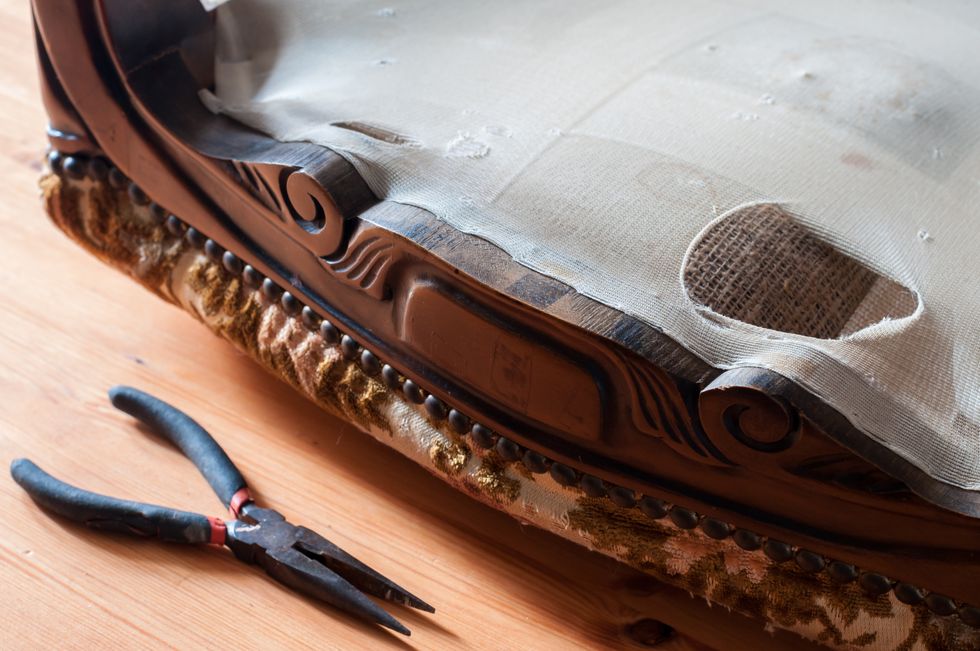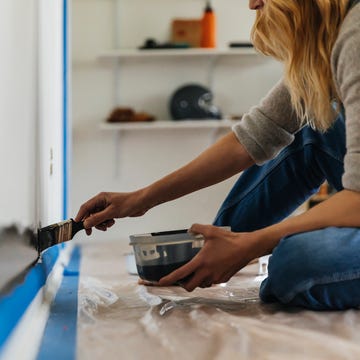On TV, the pros make reupholstering look easy. All you need to do is binge-watch HGTV and you got this... right? It's not that simple. While it is possible for beginners to handle some small reupholstery projects, you run the risk of seriously messing up a piece of furniture for jobs that are more complicated. (That heirloom piece passed down from your great grandmother? Forget about it.) Here’s how to know when it’s okay to DIY, and when to call in a pro (plus how to find one), according to experts.
Recovering vs. Reupholstering
First, it's important to understand the difference between recovering and reupholstering. Recovering is simply putting new fabric over the old fabric. “This is a way to cut corners,” says Diane Montgomery, owner of Coventry Lane Upholstery in Nashville. “We find a lot of people who recover, and in turn, I have to take all those layers off [when I reupholster].” When you’re reupholstering an item, on the other hand, you’re completely replacing the fabric and possibly installing new foam or other inserts.
The Biggest Misconception About Reupholstering
What most people get wrong is thinking it’s easy, says Montgomery. “There have been a lot of times where I’ve had clients bring me something they attempted,” she says. You can find many reupholstering videos on YouTube with experts who make the process seem like a cinch, yet when you’ve never done it before, it can end being much more difficult than you expected.
When It's Okay to DIY
Basic “whack and tack” jobs, where you’re just pulling fabric around a surface wrapped in padding and stapling it in place, are a great place to start, says Jenna Pilant, owner of Homebird Upholstery in San Diego. Dining room chairs with drop seats (like the one in the above video) are a pretty doable reupholstering project for beginners. Since the seats are usually square, it only involves figuring out how to fold the corners, says Montgomery.
Another attainable project is a simple, covered headboard. “It’s kind of like wrapping a present,” says Montgomery. You can make one by getting a piece of plywood cut to the size you want at Home Depot, adding padding to it, and wrapping and stapling your fabric around it.
When you’re opting to DIY, avoid using thick fabric like leather and vinyl, because they can be very difficult to fold, Montgomery advises.
When to Call a Pro
Anything that requires “full upholstery” (such as club chairs, ottomans, and sofas, especially those featuring tufting) is too complicated for a beginner to take on if you want the result to look professional. The exception to this: If you’re working on something inexpensive with the goal of simply learning how. “If you got a chair at Goodwill and don’t choose an expensive fabric, and it’s meant to teach you a skill, that’s one thing,” says Montgomery, “but if it’s a family heirloom with upholstered back and arms, seek the help of a professional.” Similarly, if your piece has any foundation issues—a wobbly frame or leg—take it to an expert.
A lot of upholsterers will sell fabric; however, Pilant says you shouldn’t be afraid of sourcing your own fabrics elsewhere (after finding out the exact yardage from the upholsterer you’ve hired).
Before choosing to work with an upholsterer, ask your friends who they recommend. Sites like Thumbtack and the National Upholstery Association can also help you with your search. If you find someone you might want to work with, ask if you can speak with a few of their former clients and visit their shop to see items they’ve done in person. “You need to be sure that what you’re paying for is at the standard level you’re expecting,” says Montgomery.
You love finding new design tricks. So do we. Let us share the best of them.
Follow House Beautiful on Instagram.













